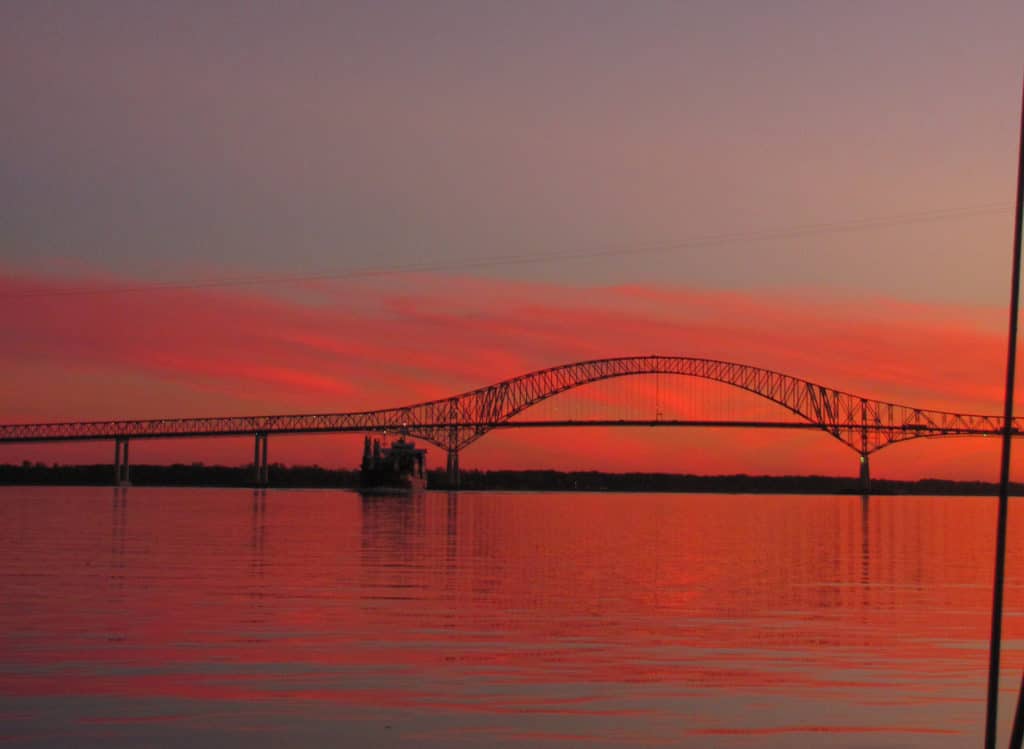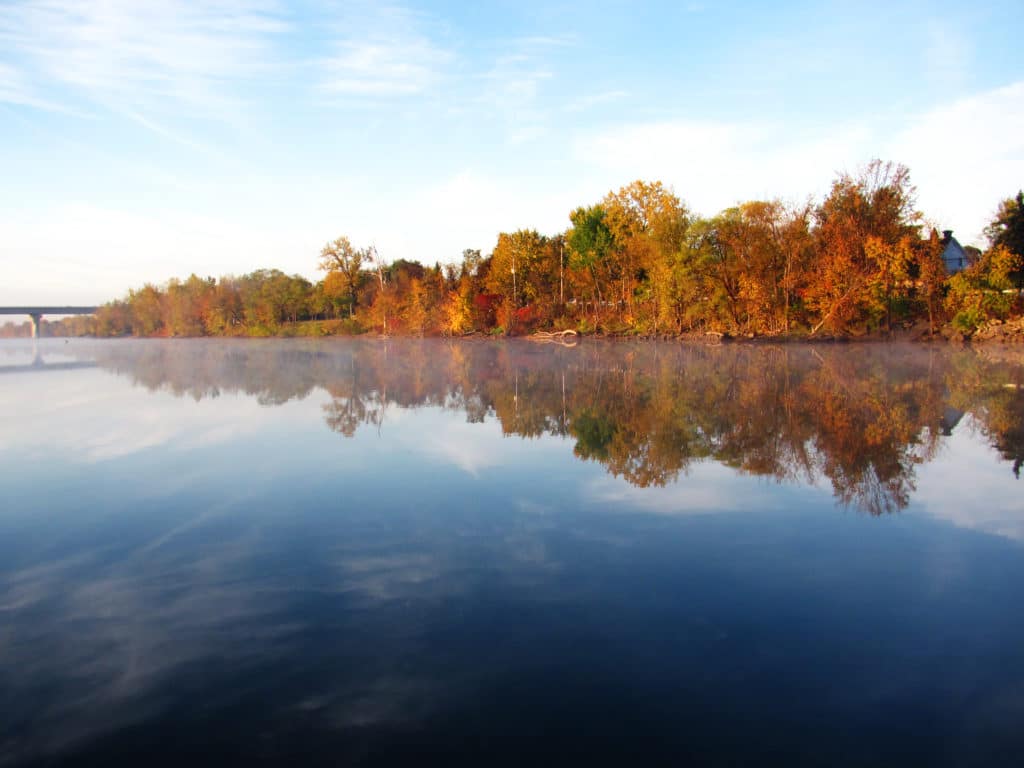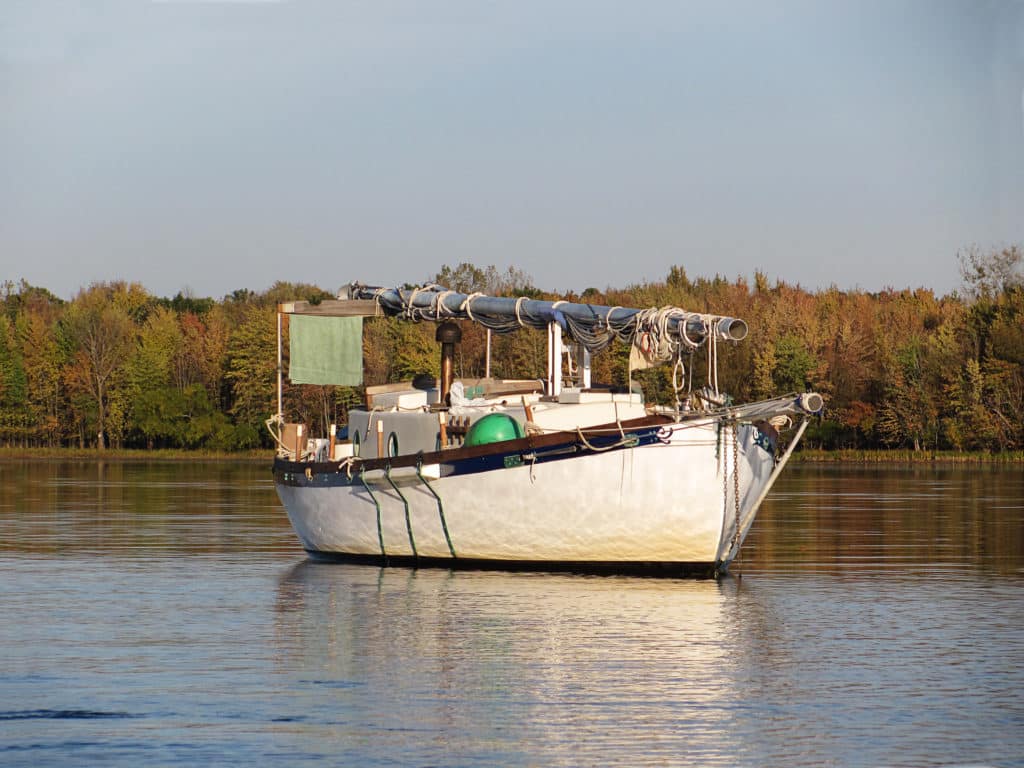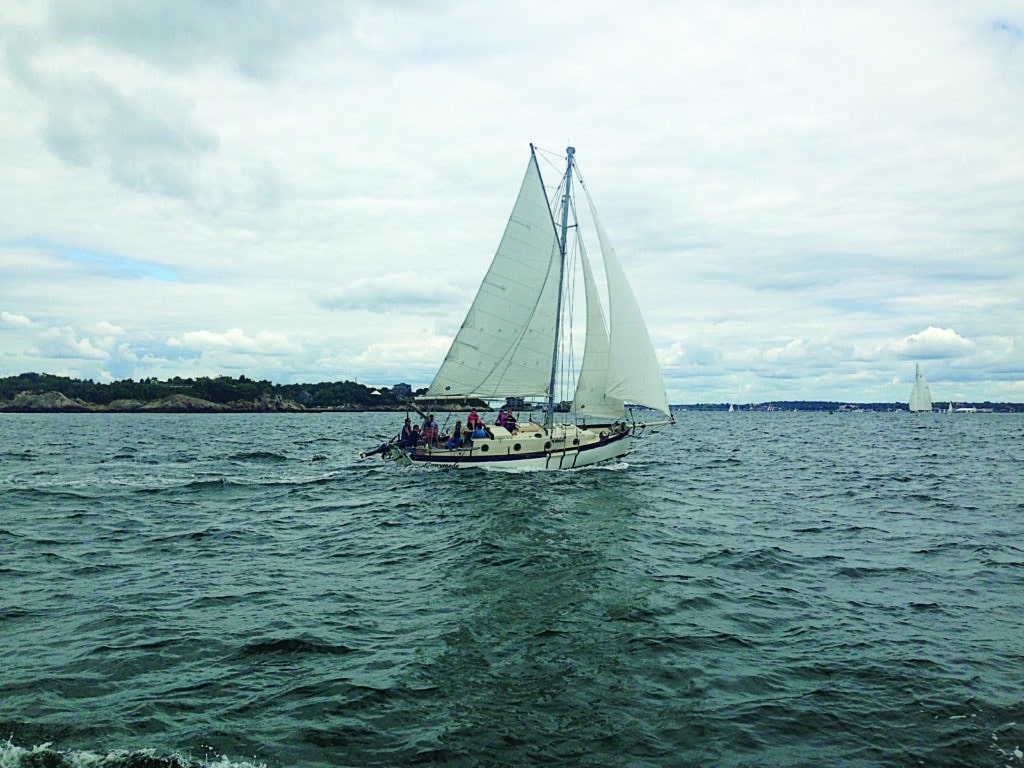
They say that the devil you know is better than the one you don’t, but more often than not in our travels on Ganymede, we’ve opted for the devil unknown over some horror we hoped to never see again. In this case, the devil we knew was the tidal overfalls we encountered at Cape Sable Island, on the southern tip of Nova Scotia, where perpetually breaking standing waves sucked in our boat, stood her on all her ends, sloshed icy seawater all over everyone, and released us only after some thorough digestion.
Add to that the trouble of working all the weary way south from Newfoundland, which we’d circumnavigated counterclockwise all summer, and sailing upwind along the swell-fraught coast of Nova Scotia to get there, while still technically in hurricane season, and it might not be surprising that we chose instead to get home to our winter slip in Newport, Rhode Island, by sailing up the St. Lawrence River and then south again through inland waters and the Hudson River to the sea.
It had been nearly six months of hard going in chilly northern latitudes since the overfalls had chewed us up on our way east in the spring, but the memory was still vivid. Besides, we did want to explore Canada’s mighty St. Lawrence River, and the lure of yet-to-be-seen places pulls strongly at a cruising sailor’s heart. Hindsight being what it is, the Nova Scotia coast, even with fog, swells and overfalls, might have been an easier choice, but that’s a kind of risk you take every time you leave the house.
It’s not as though we meant to race pell-mell up the St. Lawrence against tide, current and ever-shorter days. The plan had been to mosey slowly upstream, choosing only the best days and most helpful currents. That hope was dashed, though, when we arrived in Havre-St.-Pierre, Quebec, two days after sailing from Natashquan, Quebec, under storm trysail and reefed staysail. There we were told to our great dismay that a canal crucial to the scheme, one that we’d been counting on arriving at in five or six weeks, would be closing in exactly 14 days. Two weeks! Even if good weather and fair currents could be guaranteed, that was hardly enough time to sail the several hundred miles from the northern Gulf of St. Lawrence, higher than 52 degrees N, to Sorel-Tracy, at the western end of Lac St.-Pierre, where the St.-Ours Canal begins. The canal links the waterways that lead to Lake Champlain.
Pretty much the only thing that could be guaranteed, according to the radio weather forecasts, was a mort of bad weather as the autumnal westerlies increased in strength and constancy. Still, there was a chance — not much of one, admittedly — that if we pushed day and night whenever tide and wind allowed, we might just make it. If we arrived too late, there was the option of carrying on past the locks at Montreal to upstate New York and settling in there for a chilly winter, not exactly in a great spot, but at least not in Canada past the limit of our boat’s legal stay.

Game On
The start of the race up-river was auspicious enough: Two days of flat calm were predicted, and after a stop at the small town of Mingan to wait for a fair tide, we set off to cross Jacques Cartier and Honguedo straits, chugging under outboard for 30 hours over a strangely placid, unruffled sea. Late during the night, muffled to the eyebrows against the chill, we spied hundreds of red lights dotting the sides of the Chic-Chocs Mountains, which line the northern coast of Quebec’s Gaspé Peninsula. It turns out they were the top lights of windmills standing idle in the stillness. The next evening, tying up sleepily at dusk in the tiny yacht basin at St.-Anne-des-Monts, we were sorely tempted to rest for the night and carry on the next day. But the tide was fair, the weather quiet, and after a top-up of fuel and a pot of coffee, we set off into the gathering darkness.
The banks of the river were ablaze with lights here, and after our months of cruising where there were few or no shore lights, they made navigation easy, besides being a charming sight. But soon an even better spectacle appeared: Aurora borealis, the Northern Lights, slowly spread its dance across the heavens over the dark river, pulsing and scintillating in majestic silence. Though Danielle and the girls were asleep already, I lost no time in getting them up to see the show. Because we were heading ever farther southward, I thought this might be our only chance to see it.
As it turned out, we would see the lights again several nights later, when after three despairing days in Matane, the wind blew fair again and we made a break at dusk for Rimouski. This time the aura was fainter and appeared to be farther off, as we were farther south, and this would indeed be our final glimpse of it. But there was plenty of other stuff to pay attention to. As the river narrowed, traffic and buoyage increased, and the tides became a force to be reckoned with. Once past the Île du Bic, there was no going without a fair tide, and by the time we fetched Quebec City, the tidal range was nearly 20 feet.
It was without a doubt the most difficult two weeks of our seafaring lives, always touch-and-go as to whether we’d get into shelter before the wind blew contrary or the tide turned. Marinas and services along the St. Lawrence were closing; there was no chance to buy groceries, and always we faced the pressure of time ticking inexorably away. But for all that, it was still a grand cruise. The scenery along the upper river is glorious, all wooded hills and leaping waterfalls, and the nights provided all the exercise in seamanship one could wish. By the last frosty evening, crossing Lac St.-Pierre against a perpetual 2-knot current, though we were numb with weariness and cold, we had figured out the code of the buoy lights — quick flashing signaled a bend ahead; slow indicated a straight run — meaning we hardly consulted the chart at all.

Canal Days
Though we had raised and lowered Ganymede’s tabernacle-mounted mast several times ourselves with the help of a “sheerlegs” — a sort of makeshift crane — it had always been done in a quiet marina with helpful volunteers and plenty of time to think things through.
Arriving at Sorel-Tracy to find both marinas there shuttered and even the basins inaccessible, we were faced with the necessity of not only dropping the mast by ourselves at anchor, but without the convenience of a sheerlegs. It was the beginning of the last weekend that the locks were open, and we still had 20 miles to go to the first lock.
Lacking an alternative, we stood the boom up on the foredeck, guyed it down thoroughly, and used it to gingerly lower the mast with the aid of a tackle. It was both scary and difficult, but surprisingly fast. Just three hours after beginning to unbend the sails, Ganymede was transformed into a canal barge, with her masthead protruding over the stern and her other spars nestled on the portside deck. The canal system that connects the St. Lawrence River to the Hudson River by way of Lake Champlain is about the most scenic waterway you could ever hope to navigate — at least it seemed so to us, though much of our benevolent feeling could have been caused by getting to the locks in time.
It was also fall, and the leaves were at the height of their colorful glory, which is a remarkable spectacle in the Richelieu and Hudson river valleys. But even if it had been the most drab, yellow, boring ditch, we would have welcomed it because it meant we had made it.
No more opposing current, no more container-ship wakes, no more icy nights among the winking buoys, no more pressure to go, go, go, and no wondering what the weather was going to do.
We still had to make good time, to be sure, but we could anchor or tie up every night, stretch our legs ashore, and forage for groceries and supplies. And of course, though the girls have been through the mighty locks at the Panama Canal, the tiny, hand-operated locks in the Chambly Canal, south of Montreal, were no less a thrill. It was a strange and unique feeling to navigate a canal so narrow you could almost step off onto the old towpath, and to look down on the countryside over its raised edges. Farther along, the trees arched completely over the canal, making a low yellow tunnel and carpeting the surface with fallen leaves.
It was a most relaxing and magical way to end a cruise, and though the devil we met in the middle reaches of the St. Lawrence was rather worse than the one we were avoiding at Cape Sable, it’s good to have known them both. “Especially since,” I told Danielle at the end of October, as the lights of New York City gleamed ahead in the pre-dawn, “when we pass the Battery, we’ll have managed nothing less than a complete counterclockwise circumnavigation of New England and the Canadian Maritimes!” Danielle yawned. “Was that your plan all along?”
“No,” I admitted. “I only just now realized that. I was just trying to avoid getting beat up at Cape Sable again.”
She could have said something snarky, but bless her heart, she didn’t. “Counterclockwise circumnavigation,” she muttered. “Well, there’s glory for you.”

The well-traveled Zartmans have made Bristol, Rhode Island, their home — for now.
Read the second part of their adventure, settling in to life ashore, here.








